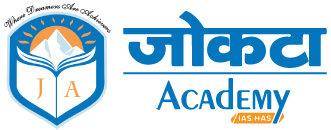Daily Mains Answer Writing Practice – Mains Questions GS-3 (UNIT-I)
Q.1 Examine the various methodologies utilized for calculating Gross Domestic Product (GDP) in India and discuss the associated challenges inherent in these approaches.
Ans.
The total final value of goods and services produced within the domestic territory of a country in a specified time period (generally a financial year) is called Gross Domestic Product (GDP).
The Various Methods to Calculate the GDP in India are:
1. The Product or Value-Added Method
- In this method, we calculate the aggregate annual value of goods and services produced and to arrive at this we add up the value of all goods and services produced by all the firms in an economy.
2. Expenditure Method
- An alternative method to calculate GDP is by examining the expenditures of all sectors.
- The total goods and services produced in an economy are ultimately purchased by the household, government, private, and external sectors.
- Therefore, summing the expenditures of these four sectors on final goods and services produced domestically equates to the country’s GDP.
- i.e., GDP = Private consumption (C) + Private investment (I) + Government Investment and Consumption (G) + Exports (X) – Imports (M).
3. Income Method
- It measures the total income earned by the factors of production.
- Income earned by all the factors of production in an economy includes the wages paid to labour, the rent earned by land, the return on capital in the form of interest, as well as corporate profits.
- i.e., GDP = Profit + Interest + Rent + Wages.
Challenges with Current GDP Calculation Methodology:
1. Accuracy of Data
- The accuracy and credibility of GDP calculations heavily rely on the quality of available data.
- Outdated data across various sectors can distort the true picture of economic activity.
- E.g., in India, the declaration cycle for GDP results spans three years, meaning accurate data for a specific fiscal year is available only after a three-year lag.
2. Accounting for the Unorganized Sector
- Currently, the GDP computation methodology uses data from the organized sector as a proxy for the unorganized sector.
- This can lead to inaccuracies, as the unorganized sector contributes significantly to the economy but is not directly measured.
3. Exclusion of Certain Activities
- Not all productive activities are included in GDP calculations.
- Unpaid work, such as household chores or volunteer work, and black-market activities are excluded because they are difficult to measure and value accurately.
4. Technological Advancements
- Rapid technological changes can make it challenging to measure the contribution of new digital services and products to the economy accurately.
5. Environmental Factors
- The traditional GDP measure does not account for environmental degradation or depletion of natural resources, which can provide a misleading picture of sustainable economic growth.
Way Forward:
- Base Year Updation – Regularly updating the base year is essential to maintain the accuracy of GDP estimates.
- The current base year of 2011-12 is now more than a decade old and needs updating.
- Double Deflation – Countries can improve GDP accuracy by adopting double deflation, where outputs and inputs are adjusted separately using appropriate price indices.
- Robust Data Collection – Timely and efficient data collection, storage, and processing can enhance GDP accuracy.
- Utilising emerging tools like Big Data and Artificial Intelligence can significantly improve this process.
- Measurement of Productive Activity – All productive activities, including voluntary work and unpaid household tasks, should be considered in GDP calculations to provide a more comprehensive economic picture.
By addressing these challenges and implementing these improvements, the accuracy and reliability of GDP as an economic indicator can be significantly enhanced, providing a better foundation for economic planning and policy-making.
Q.2 Give an account of Crypto Regulation in India. What are the needs for regulation of Crypto Assets in India and the challenges related to it?
Ans.
A crypto asset is a digital value or right that can be transferred or stored electronically using distributed ledger technology. They simplify capital raising, boost competition, and provide new financing methods for consumers and SMEs.
- Crypto assets can be used for payments, offering cheaper, faster, and more efficient cross-border transactions by reducing intermediaries.
Crypto Regulation in India:
1. Legal provision
- Currently, the exchange, transfer, safekeeping, or administration of cryptocurrencies falls under the jurisdiction of the Prevention of Money Laundering Act (PMLA) 2002.
- This mandates that all entities involved with cryptocurrencies must implement mandatory Know Your Customer (KYC) processes, report any suspicious activities, and maintain client details for a period of five years.
2. RBI’s Position on Cryptocurrencies
- The Reserve Bank of India (RBI) has raised concerns about cryptocurrencies threatening financial stability.
- In 2018, the RBI banned banks from servicing cryptocurrency transactions, effectively making them illegal.
- However, the Supreme Court overturned this ban in 2020, citing it as disproportionate and a violation of fundamental rights, thus legalizing and promoting broader adoption of cryptocurrencies in India.
- In 2022, the RBI launched its own digital currency, known as the Central Bank Digital Currency (CBDC), to regulate the digital financial market.
3. Taxation of Digital Assets
- In 2022, the Union Budget formally categorized digital assets, including cryptocurrencies, as “virtual digital assets” for the first time.
- Under the new tax regime, the government announced a flat 30% income tax on the transfer of these assets.
- Additionally, a 1% tax deducted at source (TDS) was introduced.
Need for Regulation for Crypto Assets in India:
1. Financial Stability
- Crypto assets can pose risks to financial stability due to their volatility and speculative nature.
- Effective regulation can mitigate these risks and ensure a stable financial system.
2. Consumer Protection
- Regulation helps protect investors from fraudulent schemes and scams associated with cryptocurrencies, ensuring they are better informed and safeguarded.
- E.g., a man loses nearly Rs 3 crore in a cryptocurrency scam in Mysuru, Karnataka.
3. Preventing Illegal Activities
- Proper regulation can prevent the use of cryptocurrencies for illegal activities, such as money laundering and terrorist financing, by enforcing compliance with anti-money laundering (AML) standards.
- E.g., according to a report by blockchain data company Chainalysis, since 2019, nearly $100 billion has been moved from known illegal wallets to services that convert cryptocurrency into regular money.
4. Market Integrity
- A regulatory framework ensures transparency and fairness in the crypto market, preventing market manipulation and fostering investor confidence.
5. Tax Compliance
- Regulation facilitates the effective collection of taxes on crypto transactions, ensuring that gains from digital assets are properly reported and taxed.
6. Innovation and Growth
- Clear regulations can boost innovation in the digital financial sector by offering legal clarity and helping new technologies and services develop.
Challenges in Regulating Cryptocurrency:
1. Blanket Ban
- Implementing a blanket ban on crypto-asset activities can be both costly and technically challenging to enforce.
- The borderless nature of cryptocurrencies allows for circumvention through various technological solutions, which can increase financial integrity risks and create inefficiencies.
2. Regulatory Consistency
- Achieving uniformity in cryptocurrency regulations across different countries is a complex and challenging task.
3. Lack of Harmonized Taxonomies
- Variations in how jurisdictions define and categorize crypto-assets create ambiguity regarding the associated risks and lack of clarity for market participants.
4. Fragmentation
- The lack of coordination among law enforcement agencies results in fragmented oversight of cryptocurrency activities.
5. Balancing Innovation and Risk
- Finding the right balance between promoting innovation and managing risks is a tough and tricky task.
6. Cross-Border Enforcement
- Enforcing regulations within a global, decentralized ecosystem and addressing differing national priorities present significant challenges.
Way Forward:
- Policy Implications and Responses – Understanding the effects of crypto assets and developing appropriate policy responses can be a constructive approach moving forward.
- No Outright Ban – Implementing a blanket ban on crypto-related activities, such as trading, can make enforcement difficult and challenging to monitor.
- Licensing and Supervision – Crypto asset service providers should be licensed and supervised similarly to financial institutions.
- Clarity on Taxation – A clear tax policy should address cross-border transactions and utilize third-party information, such as data from crypto-asset trading platforms and broker-dealers, to improve tax compliance.
- E.g., the G20 nations support creating a framework similar to the Crypto Asset Reporting Framework (CARF) for effective cross-border data sharing and tax compliance.
- Robust Data Framework – Authorities should have access to necessary and relevant data to effectively carry out their regulatory, supervisory, and oversight responsibilities.
Regulating crypto assets in India is essential for ensuring financial stability, protecting consumers, and preventing misuse. By implementing clear guidelines and robust oversight, India can foster a stable and transparent digital financial market that supports both growth and security.
That’s all for today’s GS answer writing practice!
Stay consistent, write daily, and master the art of structured, crisp, and analytical answers.
Don’t forget to revisit this section daily for updated questions and answers from across GS topics like History, Polity, Economy, HP GK, and more.
Got topic suggestions or doubts? Share them in the comments – we’d love to help!
This initiative is brought to you by Jokta Academy, the most trusted and result-oriented coaching institute for HPAS & Civil Services preparation in Chandigarh.
Join our online or offline mentorship programs to accelerate your success in civil services.

⏳ Don’t miss it!
🇮🇳 Independence Day Special – FLAT 20% OFF on selected Jokta Academy courses.
Learn. Grow. Succeed.
🎟 Use Coupon Code: FREEDOM20 | Valid till 20th August.

